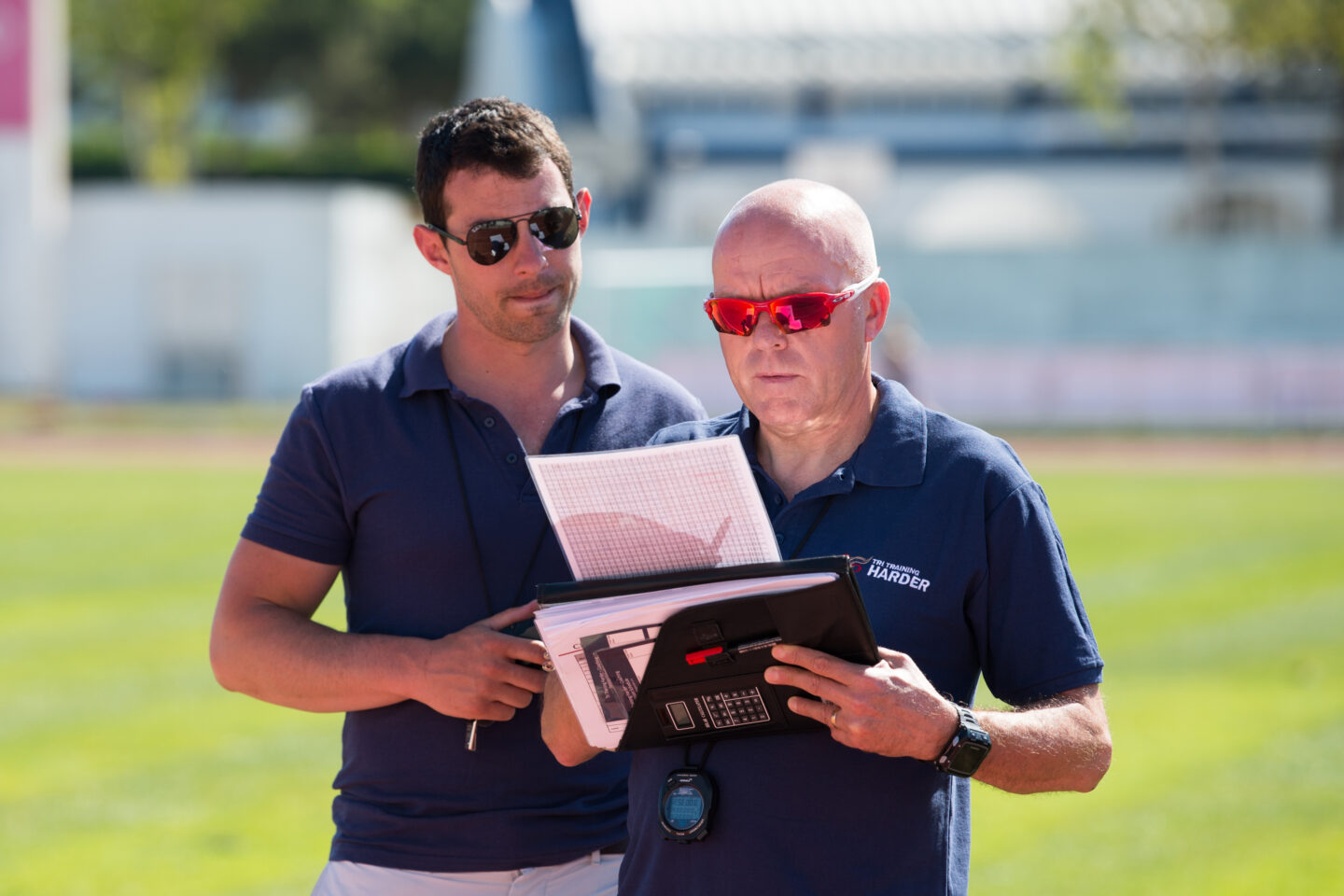There are four essentials that ensure the success, and ultimately the growth, of a coaching business:
- See that you are a business, not a volunteer.
- Acknowledge where you are in your coaching career.
- Place a value on your time—and stick to it.
- Define a consistent standard of service delivery.
In my experience, before you begin to orientate your business toward growth, these essentials need to be in place.
If you find yourself giving away your time for free, if you disregard your coaching development, or if what you offer to one athlete isn’t the same to another, then you have to ensure these are in place before you consider growing your business.
Believe that you are a business
The fundamental error that I repeatedly see when working with coaches looking to build a business is this: They don’t see themselves as a business. The way they operate is, to put it bluntly, amateur. This can be seen at both extremes. Whether you act as a timid volunteer or an overly confident executive, apply either approach to coaching and you will struggle to gain traction. Coaching is ultimately about people and the relationships you have with them. In some cases that can lead the “volunteer” coach to make poor business decisions, but excellent people decisions. On the flip side, the executive moving to coaching may overlook the nuanced care involved in a coaching service, which means they are missing the business opportunity!
Believe that you are a business and identify the focus of that business. Some coaches struggle because they bring the mindset of a club-level coach and apply it to their new initiative or business model. Maybe they don’t see the true value of their service and pitch themselves at a lower amount, giving away a lot for free. Alternatively, some coaches underestimate the communication involved in developing an athlete. If they don’t invest that additional time, they will not deliver value or results.
So, let’s begin with some critical considerations to change how you see yourself as a coach, and shift your mindset to that of a coaching business, both of which will establish a platform for growth.
TASKS
- How do you value your time? Write down how you currently operate and what an athlete receives as part of their package. What are all the costs? What do you give away for free? Does your approach look more like a free athletic club or a law firm?
- How are you showing care to your client? Identify all the ways that you go above and beyond your service delivery because you care about your clients.
Believe in yourself and plan for growth
If you have committed to making coaching a business, then you must believe in yourself, your abilities, and your capabilities. It also means you must recognize your limitations and give yourself space to grow into the role. Part of running a business is following a path and knowing where you are on the path. Be honest with where you are on the coaching journey.
To position your business for growth, you need to know what to charge your clients. Whatever you decide, think about your rates as part of the journey.
Set your rates based on what you honestly feel you are worth now, not what you think you should be worth in a few years or what you feel you should be charging as a professional coach. You can charge a fair rate with the confidence that your rates will go up in the future—plan for it. This also allows you the space to grow as you become a more experienced coach. Perhaps more importantly, it helps you avoid imposter syndrome, which paralyzes many coaches, preventing them from enjoying and growing in their role.
RELATED: Coach Philip Hatzis—From Training Camps to Training Coaches
The studies that we have conducted at Tri Training Harder have shown that a coach’s experience, reputation, and branding factor significantly into the fees that athletes are willing to pay for coaching. Experience was by far the main motivator, and that will grow with every season. Accept where you are now, knowing that your rates will increase in the next few years as you gain experience. You don’t need to have it all at once. However, this is why you’ll want to have a plan to facilitate growth. Create milestones in the journey whereupon them you will charge more, go full time, or take on a new challenge to raise your profile. The path to growth starts with knowing yourself and where you are right now.
TASK
Orientate yourself as a coach with the rest of the industry in mind. Where do you think you are in your coaching journey? Where do you believe you will grow into? What will you need to accomplish or do to confirm you have made it to the next step?

Value your time as cost and revenue
Coaching is a very straightforward business model if you account for the time for all the work you do. As you become more experienced, have good results, or build a consistent brand, you will end up being in a position to charge more. Maybe you can eventually delegate some of that work at a lower cost. Regardless, any time you spend not coaching, even if it’s time for you to do something else linked to your business, will cost you.
Therefore, spending longer on an athlete’s program or double-checking an annual plan is time that you could be working on another athlete’s training. In this style of coaching model, your time is a cost. By spending longer on something than you said you would (or planned to in your business plan), you have reduced your hourly rate and eaten into your profit margin.
It is easy to slip into these patterns when you own the business. A straightforward way to counteract this “I’ll do it as it doesn’t cost anything” phenomenon is to consider yourself an employee. If you asked a contractor to redo an annual plan because you didn’t think it was “perfect,” they would ask for extra money (overtime!).
The moment you adopt the mindset that your time is not free, you start placing a value on your time. You won’t be constrained by everyday work costs like living wages, national insurance contributions, employment taxes, et cetera.
If you don’t change that mindset, you will never get out of the hamster wheel. Until you account for every minute you are working, you will not have a sustainable business.
Take as an example, time spent writing blog posts or doing social media. This must be considered when putting together your business plan because it is a cost—it’s time that you aren’t coaching. (This is also one of the reasons that at Tri Training Harder we pay coaches for articles!) The same is true of the time it takes to put together social media posts.
Perhaps you see your own performance as critical to the success of your coaching business. If so, consider your training time as a cost to the business and include it in your business plan. In other words, pay yourself to train! Of course you need to find a way to make the business plan work, but it will remove the guilt if your stick to the plan. (At Tri Training Harder we don’t pay our coaches for their training time as we don’t feel it is an accurate measure of a coach’s coaching ability. Don’t let that stop you—every business is different and this is your decision!)
Consider other areas of your business in which you feel busy. In reality, these are problems to be addressed so you can spend more time coaching.
If you are spending longer on one athlete because you are learning something, recognize this as continual professional development. Perhaps you are doing coursework. This is fantastic and good for your professional growth. Still, there is a cost both for the course itself and the cost of your time to complete it, during which you are not coaching (i.e., bringing in revenue). When mentoring coaches, I suggest they factor professional development or any additional time they think they will need for an athlete into their business plan as a cost. Better to account for these things right from the start or you will amass costs that threaten the viability of your plan.
When you begin valuing your time as a coach and placing a premium on it, you can start building a sustainable coaching business. Even better, you can avoid doing extra bits and pieces everywhere along the way and find more enjoyment on the journey.
Be consistent with your athletes
It is easy to set up your business and then be inconsistent with the amount of time you spend with different athletes. This sounds obvious, but it is so often missed. Some coaches prefer a single type of package, and this is fine if it suits their workflow. Others use different packages to ensure that an athlete pays an amount proportionate to the amount of time that the coach is spending on their program. The first step toward being consistent is ensuring that you know how much time you plan to spend on each athlete. Once you know the amount of time allocated to a coaching package plan, you must stick to it.
Going overtime is all too common; acknowledging the time spent as true overtime is the exception rather than the rule. In my experience working with coaches, I have never come across a coach who consistently charges overtime when an athlete requires extra TLC. Other professions are only too happy to raise an invoice if you need another draft or if something else needs to be added to the package. However, coaching rarely works this way. This is why it is even more critical to be aware when you are dipping into overtime.
Coaches forget that athletes will talk to each other. It is likely one athlete will mention that they “spoke to you yesterday” or are meeting up for regular coffee meetings with you as a coach. Again, if that is what they have paid for, then that is fine. Make sure the time you spend with clients is not above and beyond the coaching contract. This inconsistency will be found out, putting in jeopardy the positive referrals that are so critical for your business. Be consistent with your athletes.
RELATED: The Secret to Retaining Athletes
TASK
Write up how much time your coaching packages/services are going to take up. Compare that to how much time you currently spend with athletes. Are these two in alignment? Do you need to make a change?
Define a direction for growth
After considering the four essentials for creating a solid platform from which a sustainable business can grow, you have a chance to decide on the direction that you want to grow. Start with these two questions:
- What is it that you do better than other people?
- Where does your passion lie?
Some coaches take aim at simply being world-best at their profession. Realistically, will you ever be the best coach in the world? This isn’t meant as dismissive, but rather realistic. Think about it—what does world-best even mean? How do you define “best” when there isn’t a prize for being the best? I have seen excellent coaching practices put to use in teaching a beginner how to swim; in equal measure, I have seen appalling coaching practices directed at elite athletes. So who you coach has no bearing on your ability, and being the “best” is an impossibility.
However, you can be the best at what you do in a specific domain. In fact, if you focus your effort on a clear, refined objective you can aim for world-best. For example, you might aim your business at this objective: To be the world-best at coaching athletes to their first triathlon in the Chicago area. An organization based in Europe would be hard-pressed to compete with your local knowledge. Work out what you can be world-best at and chase it.
Importantly though, evaluate whether this ambition is aligned with your passion. It wouldn’t make sense to commit to a plan to be world-best that involves working with beginner triathletes if you most enjoy working with professional, high-performance athletes. Identify what you are passionate about and grow your business in a direction that leverages that passion.
TASK
What can you be world-best at as a coach? What is your passion? Can you capture your potential and your passion in one or two sentences?





